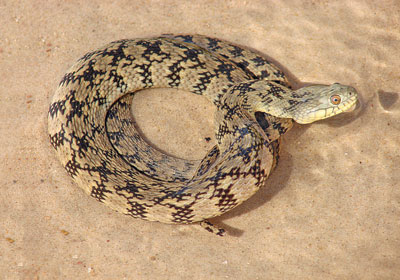|
back Home Life Along a
|
|
Diamondback Water Snake
Nerodia rhombifer|
© Laurie Vitt, Sam Noble Oklahoma Museum of Natural History |
As the name implies, this species is primarily aquatic, living in and near rivers, lakes, ponds, and riparian areas. Although called “diamondback,” the dark markings that extent the length of the snake are slightly irregularly shaped forming a chain-like pattern. Diamondback water snakes generally eat fish, but will occasionally consume large tadpoles (such as bullfrogs), frogs, reptiles, mammals, and some large invertebrates (such as crayfish). Most activity, including hunting, occurs just before dark and at night (diurnal), except during very hot weather, when it is nocturnal. These live-bearing snakes produce young from mid-August through early October. Very large females can give birth to as many as 48–50 young, but fewer offspring is more typical. As an adult, this species of snake can reach up to 1.2 m, but because they are heavy-bodied they can appear much bigger. These conspicuous snakes can be easily observed along shorelines and on branches that overhang water. Frequently basking on top of branches, they drop into the water when approached. In Oklahoma, this species is found statewide except the panhandle. Within North America, the distribution extends from east Texas to eastern Alabama and from central Illinois south into Mexico. This species is common in the wild, but is also found in farm ponds, streams flowing through towns, and urban lakes and ponds. In fact, they may be more common now due to the abundance of ponds in residential and commercial developments. Diamondback water snakes are non-venomous and generally harmless, but they may bite if handled. |
|
back to species list |
PDF of all species profiles
|

